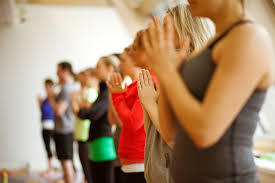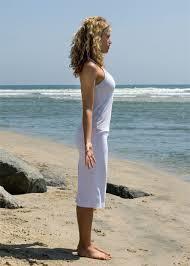Standing still, standing tall and standing in balance, with the grace and dignity of the mountain, Tadasana invites us to focus attention in the body. We become alert, yet tranquil and align with something larger than our little selves. ADVERTISING
Standing still, standing tall and standing in balance, with the grace and dignity of the mountain, Tadasana invites us to focus attention in the body. We become alert, yet tranquil and align with something larger than our little selves.
All standing postures rely on the spine’s dance with gravity. Inner adjustments made in Tadasana set an example for the body to relearn the natural way to relate to gravity, feel inner buoyancy and see the highest potential in all beings.
The mountain tells the story of this ancient relationship. While being heaps of earth, rock, water, wind, animals and flowers, the mountain is also a symbol for rising above it, overcoming obstacles, knowing where we stand, being true, straightforward, righteous, and in Hawaiian, pono.
In yoga, we climb the sacred mountain of the spine with the laser focus of the mind, moving deeper inside the tissues through co-contraction, simultaneously contracting agonist and antagonist muscles to stabilize a joint. For instance, a balanced isometric contraction of the peroneus longus and brevis and the tibialis posterior muscles stabilizes the ankle joint. (See illustration.)
In time, we arrive at the point where heaven and earth meet, literally and symbolically, at the royal spot, the crown of the head. Inner peacefulness radiates into outer harmony.
Tada translates as mountain, while asana means a position that is firm yet serene. Tadasana invokes Samasthiti (equal standing), a command to bring awareness to the breath, come back to our own living center and reconnect with the life force inside us, that which already exists, our wholeness. Sama draws the edges of the body in to the center. Sthiti brings constancy and strength. One stands immovable, as a mountain, yet also supple, like the wind, water and fire moving within.
Steps for Tadasana
Breathe deeply through the nostrils with the mouth closed for the entire sequence. Reside inside your body, front to back, side to side, top of head to tips of fingers and toes.
1. Bring both feet together and stand facing forward. Spread the weight of the upper body evenly across the feet. Press the back part of the heels into the floor and distribute the weight across the balls of the feet. Fan the toes, extending them, then place them gently on the floor. Root the balls of the big toes into the earth and engage the muscles around the outer ankle bone inward. Lift the arches of the feet upward. Extend your tailbone toward the ground; lift your crown toward the sky.
2. Work your way up the legs, lifting your ankles out of the feet and draw the shinbones up and back while the calf muscles contract forward. Draw the inner knees together. Lengthen the inner legs upward the groin. Engage the quadriceps muscles by lifting the knee cap, while co-contracting the hamstring muscles. Tuck in the skin and flesh at the top of the backs of the thighs. Move energy up to the pelvis, firming up the outer knee to the hip bones and squeezing the side hips gently inward to stabilize your core. Bring the coccyx and sacrum forward but keep the pubis tucked up and back. Lift the lower abdomen up without tensing. Draw the navel back and tuck the waist in from all sides.
3. Continue breathing into every cell and fiber. Balance extension and flexion of the lumbar spine, and engage the abdominal muscles inward to prevent the lower ribs from bulging forward. Align the vertebral column so that the chest perches effortlessly over the pelvis, knees and feet and the spine assumes its natural curvature. Let little asymmetries along the spine even out so left and right sides feel equal.
4. Move the kidneys inward. Lift the sternum and broaden the collarbones while still pressing the feet into the earth. Roll the upper arm bones back. Extend the elbows and point the fingertips from the underarms and side ribs down to the floor evenly. Release the trapezius down the back and lengthen the shoulder blades toward the waist. Feel lungs breathing deeply, expanding and releasing the back, chest and rib cage. Lengthen the spine and neck, relax the jaw and soften the face. From the belly, send an inner smile up to the eyes.
5 – Keeping the lips together, gaze softly. Attach the mind to the breath and center evenly on the steady, friendly attitude of the mountain. Elevate the palate at the roof of the mouth to balance the brain, gently breathing into the corpus callosum, the bundle of 200-250 million neurons that connects the left and right cerebral hemispheres. Lift the back of the skull away from the neck; make the head light. A clear mind fills every sector of the body, bringing harmony, poise, and intelligence.
6 – As a variation, extend the elbows to lift the arms overhead. Draw the scapulae away from the ears and down the back to free the neck. Clasp hands overhead, knuckles to the sky. Stretch upward while pressing the energetic roots of the feet deeply into the earth. If it’s safe for your neck, allow the head to tilt back and reach the eyes up to the sky. Facing forward again, turn hands to aim palms to the sky. Bend to the right, extending in a right curve for a full inhale and exhale, and then bend to the left, breathing fully, feeling your wholeness. Come back to center. Reside fully in your body, inhabiting the front, sides and back of your feet, pelvis, chest and head.
Marya Mann is writer and yoga teacher. Contact her at marya.mann@gmail.com





